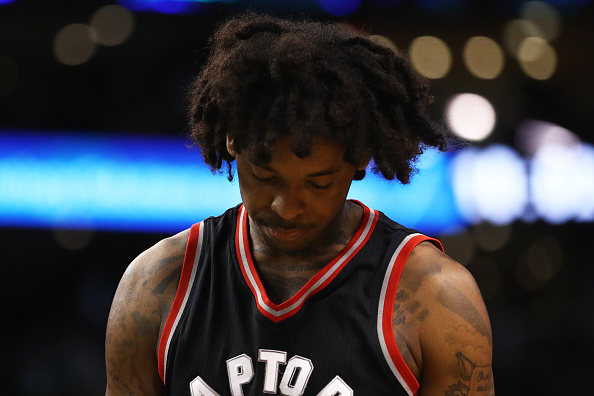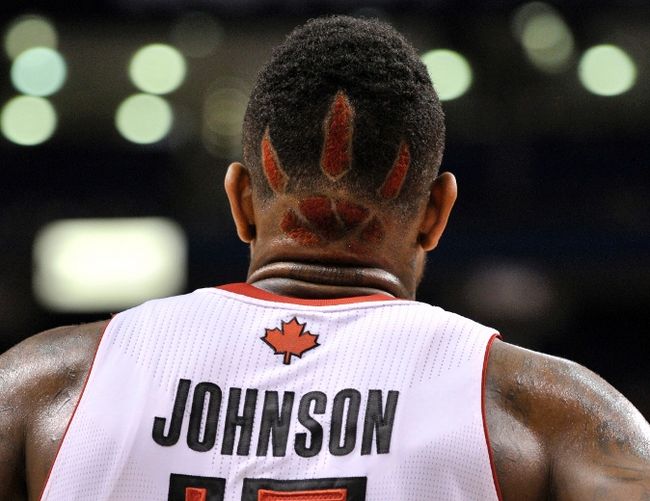In mid-November, Lucas Nogueira hid his face in a towel inside the Toronto Raptors locker room. On the surface, it looked like he was just wiping sweat away after a shower didn’t fully take. In reality, though, Nogueira needed a moment to dim the thousand-watt smile that was betraying just how much this game had meant to him.It had been Nogueira’s fourth strong game in a row, and after teammates had hugged him on the court, they were now clowning him as his scrum started. In a season full of big moments, it was one of the more touching, the degree to which teammates have believed in and rooted for the affable Brazilian on full display.
Fast-forward to the first round of the playoffs, and Nogueira’s most notable post-game moment was far more somber. After Norman Powell had yet another series-swinging performance, Nogueira asked Powell earnestly how he stays ready, how he can deal with the mental ups and downs of sitting in wait for an opportunity for long stretches, and shake it all off and perform when needed.
That these nights happened in the order they did underscores another season that grades somewhere between disappointing and frustrating for Nogueira, and it starts all the way back in training camp. It probably starts two training camps prior to that, really, when an injury sidelined him and rendered him a co-14th/15th man with Bruno Caboclo for his rookie NBA season, despite having enjoyed notable success internationally. In the year between, Nogueira was meant to compete with Bismack Biyombo for the backup role, but Nogueira suffered another camp injury, and Biyombo, well, everyone knows what he did with that backup spot. At least 2015-16 offered a brief glimpse of what Nogueira could offer, with the 7-plus-footer stepping up big in a small handful of games before falling injured again.
So this past fall, Nogueira set out to lock down the backup role again, this time opposite lottery pick Jakob Poeltl. Nogueira had a strong offseason, came to camp stronger, and outperformed the rookie. With a few days left in camp, it was all but plain that Nogueira had won the backup role. He looked good. Naturally, he once again suffered a minor injury, and it wouldn’t be until the team’s sixth game of the season that Nogueira took his presumed job back.
When he did, Nogueira was about as good as the Raptors could have possibly hoped. Blessed with ridiculous length, Nogueira provided a reasonable facsimile of Biyombo’s rim protection, mimicked Jonas Valanciunas’ role as a bone-crunching screen-setter (he was third in the NBA in screen assists per-minute), and provided the team’s ball-handlers, Kyle Lowry in particular, with an easy lob target. Nogueira also managed to flash a modicum of range and, most importantly to the Raptors’ offense, was easily their best-passing big, maybe even their best-passing non-All-Star. Nogueira’s ability to read the floor quickly and willingness to pass out of 4-on-3 scenarios made him a valuable two-way piece, even if there were still some clear weaknesses (he’s not an elite rebounder, is susceptible to being bullied in the post, and while he was the team’s best high-waller in the side pick-and-roll, his length can’t always make up for foot speed defending larger swaths of space in the middle of the floor, though he does manage to hedge without sacrificing the rim).
Nogueira was so good, in fact, that with injuries to the power forward position, head coach Dwane Casey opted to start Nogueira at the four alongside Valanciunas. It was a move borne of necessity, sure, but for a player who’d struggled to maintain the trust of a coach and who, on paper, doesn’t look much like a power forward, it was a big vote of confidence. That duo didn’t have to play together long enough for it’s obvious long-term weaknesses to be exposed, and they ended the year as a fun and surprisingly useful short-term footnote. Nogueira even capably slid back into his backup role after that experiment came to a close.
What Nogueira couldn’t deal with, though, was the acquisition of Serge Ibaka. Or so it seems. It’s difficult to ascribe, in retrospect, a reason for Nogueira’s poorly timed struggles, but after a shaky game entering the break, Nogueira came out of All-Star week with a pair of poor showings in a row. Center minutes were now at a premium, with Ibaka better off spending minutes at the five, Valanciunas still firmly in the rotation, and Poeltl proving capable of filling in when a third center was needed. That momentary blip in Nogueira’s season allowed Poeltl to grab a bit of a stranglehold on the few minutes that were available behind the starters, and to his credit, the rookie proved steady. Poeltl led all rookies who played at least 500 minutes in Win Shares per-48 minutes, showed advanced basketball IQ and play-reading at both ends of the floor (those offensive rebounds!), and did enough things well without taking much off the table. There weren’t many occasions on which he swung games, but in that role, Casey came to prefer the floor of Poeltl, and the developmental benefit to playing him, over Nogueira’s ceiling. From Feb. 27 on, Nogueira appeared in just seven games, playing almost exclusively garbage time.
That Nogueira never got another chance is both completely understandable and endlessly frustrating. From Casey’s perspective, the backup center position was meant to be fluid all year. And Poeltl, a player the team is very high on, was really solid. There were only brief windows in which you could capably argue Poeltl had lost the spot. And arguing that a player deserved another chance over someone who was performing mostly fine is tough. Nogueira’s also quite inconsistent, both on the court and off, and by his own admission can struggle to stay completely dialed in when not firmly in the mix. Casey probably would have gone to him if necessary at some point, but that opportunity didn’t arise in the season’s final two months. (There were much, much better arguments for giving Nogueira another chance in the Milwaukee series, when his length and passing would have been a nice antidote to some of what the Bucks were doing, and in the Cavaliers series, where upside was all that really mattered.)
All told, Nogueira’s third season was still mostly a success. He played more than ever before, averaging 4.4 points, 4.3 rebounds, and 1.6 blocks in 19.1 minutes over 57 games. He shot 66 percent from the floor and shattered the Raptors’ franchise record for true-shooting percentage (68.2) depending on where you draw the minutes cut off (he played 1,088). His usage was cripplingly low, sure, and he turned the ball over way too often when he did get it, but his ability to finish on the dive and draw fouls in the paint rendered him a positive. He also blocked 7.2 percent of opponent 2-point field goals while on the floor, second only to Joel Embiid among players with 500 minutes played (and better than even Biyombo’s mark the year prior), and opponents shot just 47.9 percent at the rim when Nogueira was defending, a really strong mark.
Nogueira’s impact looks even better by advanced metrics. Yes, they can be noisy in small-ish samples, and they’re not a proper tell-all. Purely to be descriptive, though, the Raptors played extremely well with Nogueira on the floor – he trailed only Fred VanVleet and Patrick Patterson on the team in Net Rating, he was fourth on the team in Win Shares per-48 minutes, and second to only Kyle Lowry in VORP and Box Plus-Minus (the drop-off from Nogueira to anyone else is extreme). Patterson draws well-deserved raves for being a no-stats all-star of sorts, but Nogueira was right there with him, or higher, in most metrics. League-wide, the big-man ranked top-50 in Win Shares per-48, top-20 in Box Plus-Minus, and top-5 at the position in Real Plus-Minus. That he did all of that without scoring much speaks to his unique value, with NBA Math showing he not only ranked 35th in total points added but was in the top-20 in providing value outside of points (these are counting stats, so his ranks in a muted role are even more impressive). Again, none of this is the proverbial mic drop, but that almost every metric suggests that Nogueira was a valuable piece for a long stretch of the season helps confirm what the eye-test showed for most of the year (and that Casey himself confirmed by closing games with Nogueira quite often when he was still in the rotation).
It would seem, then, that Nogueira was underutilized, like his good pal James Johnson the years prior. Like with Johnson in 2015-16, though, it’s at least easy to understand the reasons behind the usage (Johnson was ineffective and jumped by Powell, dealt with plantar fasciitis, and his conditioning waned; there are no such excuses for Johnson’s 2014-15 usage). But like with Johnson, there is a growing feeling that Nogueira might end up thriving elsewhere, either from a fresh start or change of scenery, or just because his role moving forward with the Raptors is unclear.
Whatever lane the Raptors take, it’s hard to see where Nogueira fits. If Ibaka returns, he’ll likely be eating minutes at the center position. In the unlikely event that both Ibaka and Valanciunas are back, there are precious few minutes at center to go around, and Nogueira would be fighting with Poeltl and Pascal Siakam for leftovers. If just one of Ibaka or Valanciunas are back, Poeltl probably has the inside track on the backup spot, by force of inertia and because the team invested the No. 9 pick in him and have him under contract for longer. (Nogueira, meanwhile, is a year from restricted free agency, and it would seem somewhat unlikely the team will re-invest with an extension prior to Oct. 31. That doesn’t mean he won’t be back, just that the Raptors may not want to commit beyond his $2.95-million salary for 2017-18 at this point.) And if the Raptors blow things up, Nogueira is still incredibly interesting at just 24, but would be competing with Valanciunas (maybe), Poeltl, Siakam, and perhaps the No. 23 pick (that area of the draft is rich with bigs this year) for development time.
It puts the Raptors and Nogueira in an interesting position. Nogueira’s salary is a little more than you’d want to pay a third center, but Nogueira is a good third-string center, and unloading him just to move him wouldn’t provide nearly enough luxury tax savings to matter much relative to other pieces. It’s possible Nogueira is attractive enough, given his age, length, and unique skillset, to return an asset, but teams may balk at paying too much ahead of restricted free agency, when a good season would mean Nogueira is far more expensive in 2018. Keeping Nogueira would almost certainly be the best way to proceed from a sheer asset-management perspective, but it almost feels wasteful – the team doesn’t owe Nogueira an opportunity or a fresh start, but he’s at least earned another chance to compete for a meaningful role, because he was really good in one.
There isn’t an easy answer here. As a professional, Nogueira has to take a page out of Powell’s book and use the lack of a clear opportunity as the offseason motivation to force an opportunity in training camp. That sort of mental growth, plus a little strength in the lower half, might be the biggest pieces of development Nogueira needs to hone this summer. It’s going to be a tough road to take minutes from the incumbent center depth chart. Nogueira has shown for significant stretches that he can play well enough to do just that.



